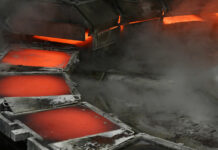
ALPHAMIN said today that following a strategic review it planned to increase production about 67% from its Bisie mine in the Democratic Republic of Congo rather than sell the company.
“At this point in time, the company believes that an outright sale transaction would not deliver the future value it intends to unlock through ongoing resource development and production growth,” it said in a market update.
An expansion of the Mpama South deposit would result in annual production of about 20,000 tons of contained tin – about 6% of world tin supply – which compares to its current run-rate of 12,000 tons of contained tin. Production for the June quarter of 3,180 tons of tin represented a quarterly record.
Global tin supply was likely to be “constrained for at least the next five years” while demand was expected to increase, the company said. In addition to developing Mpama South expansion, Alphamin said it would explore for more tin resources within the Bisie licence area.
It intended to “deliver additional mine developments and incrementally increase tin supply into an expected widening market deficit,” it said.
Shares in the company shed 2.7% on the Johannesburg Stock Exchange taking year-to-date losses to 16%. On a one year basis, however, shares in the company are nearly 23% higher and spiked to more than double their current value during January.
Alphamin also said it would pay a record interim cash dividend of three Canadian cents per share, equal to about C$30m. Net cash including a $43.5m corporate tax payment to the DRC, increased $8.3m during the second quarter to close at $138.1m.
Tin bulls’ describe the metal as “the glue” of the internet of things. The reference is to its end use as a solder in the manufacture of electronics, as well as packaging. But tin also has an application in the manufacture of lithium-ion batteries, the science behind electric vehicles. Cited by a Reuters report last year, the International Tin Association reckoned 60,000 tons of tin demand can come from electric vehicles alone.
Alphamin’s studies suggest that even at an annual growth rate of between 2% to 3% an additional 8,000 to 10,000/t in tin demand will be generated. Bisie is shooting for production of 12,000 t this year which means global demand needs a new mine like Bisie every year for the foreseeable future, said Alphamin CEO Maritz Smith in an interview in January.
Set against this demand picture new tin production to help plug the demand growth is limited. “It’ll take time for new mines to come on stream so there’ll definitely be an interim lag,” said Smith. “We could see the tin price higher over the next two to four years.”










